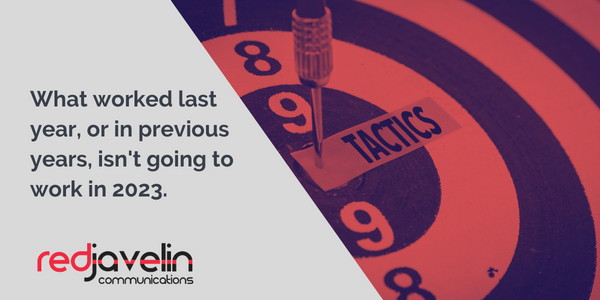
Gone are the days when a single marketing tactic would drive success. Whether it was a new website, Google Ads, an occasional blog post, or a press release, single isolated tactics no longer bring the results most companies expect.
Your prospects are inundated with all kinds of messages from all types of vendors. Inboxes are full of useless emails. Social feeds feel like a disjointed magazine full of ads with very little content. Even online searches bring up aggregated, curated, or unrelated sites, making it hard to find original content.
You are frustrated, and your prospects are frustrated.
Given that only 5% of your potential market is "in market" or looking for a solution) at any given time, it takes more touches with more people in organizations to get anyone's attention.
Prospects would rather research online and are not interested in talking until they have to; by that time, they are nearly 80% through their decision-making process. They are in control of the process more than ever before and have more resources at their fingertips to learn about your business without you even knowing they're looking around.
What worked last year, or in previous years, isn't going to work in 2023. You'll need a new playbook, a new strategy, and a new set of tactics for executing campaigns.
It's not one thing you have to do to generate the surround sound effect needed to get the momentum going; it's ALL these things. Yes, all these things, and you must do them well, often, and in concert. You'll see reduced business outcomes even if one of these is missing.
- A Sales-Ready Website – Your website is a statement about your business and connects you to your audiences. It puts your customer needs front and center to inspire action. A sales-ready website accelerates prospects through the buying process by educating them on your products and services.
- A Flexible and Agile Tech Stack – is one of the most important building blocks. You need a tech stack that eliminates data silos and provides a 360 view of your customers and their activity. If you use eight or ten-point solutions, getting all of your activities to work in concert will be nearly impossible.
- Compelling Message that Speaks to your Audience - In B2B marketing, your message strategy is the foundation of everything you do. Instead of a long list of features, functions, or capabilities, messaging must focus on business outcomes, be relevant in today's market, and communicate your value propositions succinctly.
- Strong Thought Leadership - Companies that rise to leadership positions consistently communicate vision and validation across all channels. Your executives should move the conversation with customers from operational-specific discussions to broader and longer-term strategic conversations. Thought leadership is essential to any successful marketing program and helps you build a more competitive reputation.
- Programmatic Organic Social Program – LinkedIn recommends that you post "daily" company updates. However, most engagement happens on Tuesdays, Wednesdays, and Thursdays. The lifespan of a Tweet is 18-19 minutes. You must programmatically fill your channels with relevant information to increase your reach.
- Content for Every Step of the Buying Journey – The quality of your content will determine whether your prospects will engage with you. You must create a customer-value ecosystem where you offer value (educational content) at each step in the buying process.
- PR Program – A programmatic news and proactive pitching program based on your thought leadership will help you gain earned media which is still one of the most respected channels for B2B buyers to gather information.
- SEO – All of your content and website need to be search optimized so that prospects, particularly prospects in the early awareness stage, can find you while searching on the web.
- Lead Scoring System – A solid lead scoring system will help you determine when a prospect becomes an actual lead. This will ensure that your sales team is highly focused on prospects that are “in market” and are ready to buy.
- Clean and Segmented Data - This is critical. I am sure you have heard of the term garbage in, garbage out. Your data needs to be clean and up to date, or you will waste precious resources on bad data. Segmenting your contact database into personas and target markets helps you accurately target your efforts.
- Paid Social Program – Paid social can be very effective; however, it is very expensive. An entry-level LinkedIn campaign will run around $15K to get results.
- Paid Search Marketing – These are the ads that you see at the top and bottom of search pages – i.e., Google Ads. These types of ads are important when your solution has crossed the chasm and buyers already understand they have a problem. Buyers need to see your company listed at the top of the search, whether it is a paid ad or achieved by organic SEO.
Need help getting started? Sign up for a free consultation.




